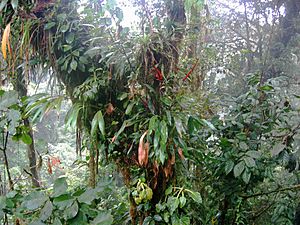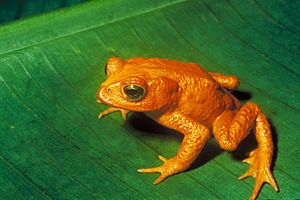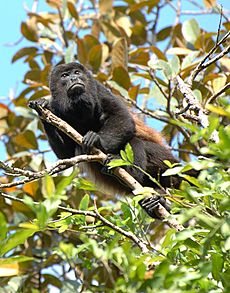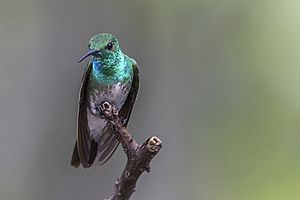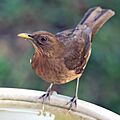Wildlife of Costa Rica facts for kids
The wildlife of Costa Rica includes all the amazing animals, fungi, and plants that live naturally in this Central American country. Costa Rica has a huge variety of wildlife! This is because it's located right between North and South America, has a warm climate, and many different types of habitats.
Costa Rica is home to over 500,000 different kinds of living things. This is almost 5% of all the species on Earth, making Costa Rica one of the top 20 countries for biodiversity in the world. More than 300,000 of these species are insects!
One big reason for Costa Rica's rich biodiversity is that the land, including what is now Panama, formed a natural bridge connecting North and South America about three to five million years ago. This bridge allowed plants and animals from both continents to mix and create new life.
Contents
Amazing Biodiversity
Costa Rica has the highest number of different living things per square mile of any country. Even though it's only a tiny part of Earth's land (one-thirtieth of a percent!), it holds four percent of all species on the planet. Hundreds of these species are found only in Costa Rica and nowhere else. These special species include frogs, snakes, lizards, birds like finches and hummingbirds, and many types of fish.
Costa Rica also has three special places recognized by UNESCO as World Heritage Sites. These are natural areas that are important for everyone to protect:
- The Talamanca Mountain Range – La Amistad Reserves / International Friendship Park (chosen in 1983)
- The Isla del Coco National Park (chosen in 1997)
- The Guanacaste Conservation Area (chosen in 1999)
Costa Rica's amazing biodiversity comes from its many different ecosystems. It has tropical rainforests, dry forests, Atlantic and Pacific coastlines, cloud forests, and mangrove forests. All these different environments provide many unique places for different species to live.
Benefits of Biodiversity
Costa Rica is a great example of how developing countries can protect their biodiversity. More than 27% of the country's land is protected as national parks, wildlife refuges, or forest preserves. The Costa Rican government actively works to protect its biodiversity because of the important services nature provides.
For example, the government uses a small tax on gasoline to pay landowners. This money encourages them to plant trees instead of cutting down forests for cattle ranching. These tree farms still provide some habitat for wildlife, helping to keep biodiversity alive even when humans use the land.
Costa Rica's biodiversity helps with many natural services. Every part of the ecosystem, from different plants to various animals, helps with things like cleaning water, providing food, fuel, and materials, recycling nutrients, pollinating plants, spreading seeds, and even regulating the climate. The more diverse the species, the better these natural services work.
Biodiversity also helps Costa Rica's economy. Ecotourism brings in a lot of money for the country. Ecotourism means traveling to beautiful, often wild, natural places, especially to help protect them and see wildlife. Costa Rica's rich biodiversity makes it a very popular place for ecotourism. Many tourists visit just to experience nature. This profitable industry encourages businesses to protect and preserve natural resources instead of using them up.
Threats to Biodiversity
Sadly, Costa Rica's biodiversity faces some dangers. A fast-growing human population, building along the coast for tourism, and harmful farming methods all lead to pollution and damage to the environment. The biggest worry for Costa Rica's environment is deforestation, which is the clearing of forests.
Costa Rica has one of the highest rates of deforestation in the world. Almost four percent of its forests are cut down every year. Clearing land for cattle ranching is the most common reason. This damage, along with farming only one type of crop (monocultures), creates areas where only a few plant species can grow. When plant diversity goes down, animal diversity also decreases.
Insects
Butterflies and Moths: Life Cycle and Adaptations
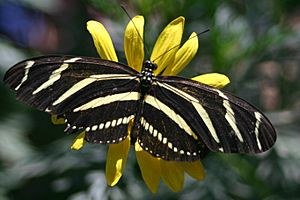
Costa Rica is home to about 1,251 types of butterflies and at least 8,000 types of moths. You can see butterflies and moths all year round, but there are more of them during the rainy season. A huge number, ten percent, of all known butterfly species worldwide live in Costa Rica!
Costa Rican butterflies and moths have developed amazing ways to survive in their environment. For example:
- Swallowtail caterpillars can look like bird droppings to fool predators. Many others have bright colors to warn predators that they are poisonous.
- What might look like a butterfly, a wasp, or even a leaf could actually be a moth pretending to be something else to protect itself.
Butterflies are very important for Costa Rica's ecotourism. They bring life to tropical forests, not just with their beautiful colors, but also by helping to pollinate the magnificent flowers.
Some common butterflies and moths in Costa Rica include:
- Thoas swallowtail
- Amber daggerwing
- Silver emperor
- Banded peacock
- Zebra longwing
- Morpho butterfly
- Green page moth
- Glasswing
Other notable insects in Costa Rica are stingless bees and sweat bees, ants like leaf-cutter ants and army ants, the huge Hercules beetle, and many katydids.
Other Invertebrates
Invertebrates, which are animals without backbones, make up most of Costa Rica's wildlife. Out of the estimated 500,000 species, about 493,000 are invertebrates, including spiders and crabs. There are tens of thousands of insects and tiny invertebrates in every type of land and at every elevation. However, many of them are still unknown or haven't been identified yet.
There are 183 known species and subspecies of land snails and slugs in Costa Rica, plus many freshwater snails and clams.
Amphibians
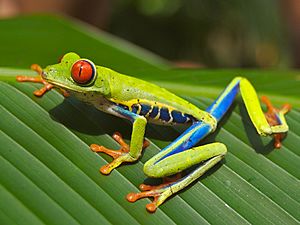
Costa Rica is home to about 175 types of amphibians, and 85% of these are frogs. Frogs in Costa Rica have clever ways to find water without fish to raise their young. Fish would eat the tadpoles and eggs. For example, poison dart frogs lay their eggs in small pools of water found inside bromeliad plants. Other frogs search ponds carefully before laying eggs or lay them in wet soil. There are many species of Elutherodoctylus frogs, Hyla frogs, and glassfrogs.
Famous frog species in Costa Rica include the red-eyed tree frog, several types of poison dart frogs, the see-through glassfrogs, and the large smoky jungle frog. Some notable toad species include the ten types of Bufo toads and the giant toad. The giant toad is huge and known for eating almost anything, including vegetables, ants, spiders, smaller toads, mice, and other small mammals.
Besides frogs, about 40 species of lungless salamanders and two species of caecilians (which look like worms or snakes) live in Costa Rica. These are rarely seen and not much is known about them. Costa Rican amphibians range in size from the tiny rainforest rocket frog, which is only 1.5 cm (0.5 in) long, to the giant toad, which can be up to 15 cm (6 in) long and weigh 2 kg (4.4 lb).
All three types of amphibians – caecilians, salamanders, and frogs/toads – live in Costa Rica. However, due to environmental damage and how sensitive amphibians are to pollution, Costa Rica has seen amphibian populations decrease, and some have even disappeared. The Monteverde Cloud Forest Reserve is a very important home for certain frog species. Sadly, about forty percent of the frogs and toads in this reserve are thought to have become extinct since 1987. This means twenty species of frogs and toads are gone.
The golden toad, Bufo periglenes, which lived in the highlands, has not been seen in its small habitat in Costa Rica's central mountains since 1989. In just one year, the number of young toads at their main breeding spot dropped from over 1,500 to only one. The International Union for Conservation of Nature (IUCN) declared the golden toad endangered, but it is likely extinct because it hasn't been seen in over two decades. Scientists think the toad's disappearance was caused by a mix of very strong El Nino weather patterns (which caused a drought), more pollution, climate change, and an invasive fungus.
Amphibians in Costa Rica have developed many ways to survive. Some frog species, especially poison dart frogs, have learned to lay eggs in water without fish. For some, this means laying eggs in small puddles in leaf litter, then carrying the eggs to bromeliads. Other species have adapted to direct development. This means the frog develops completely inside the egg without becoming a tadpole first. This protects them from predators, and the frog hatches as a tiny froglet, much better able to protect itself.
Reptiles
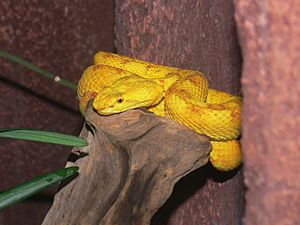
About 225 types of reptiles are found in Costa Rica. This includes over 70 species of lizards, most of which are small, forest-dwelling anoles. Larger lizards like the striped basilisk, black iguana, and green iguana are probably the reptiles you'll see most often. There are about 120 species of snakes in the country, including 5 powerful boas and many different harmless colubrids.
There are about 20 types of venomous snakes, including colorful coral snakes and various vipers like the common eyelash viper and two large, impressive bushmasters. Venomous snakes in Costa Rica are often seen without problems if you keep a safe distance.
Among turtles, five of the world's seven species of sea turtles lay their eggs on Costa Rica's beaches. Two types of crocodilians, the common spectacled caiman and the large, sometimes dangerous American crocodile, are found in Costa Rica. The country's reptiles range in size from the delicate 15 cm (6 in) Hallowell's centipede snake to the huge leatherback turtle, which can weigh 500 kg (1100 lb) and be 150 cm (60 in) long.
Mammals
Costa Rica is home to nearly 250 species of mammals. Medium-sized forest mammals are often the most popular animals to see. These include four species of monkeys, such as the active white-headed capuchin and noisy mantled howlers; two species of sloths; the clever white-nosed coati; and the fierce hunter, the tayra.
Bats make up more than half of the mammal species in the country, surprisingly outnumbering rodents by two to one. Bats have adapted to eat different foods and use various hunting methods. They eat nectar, fish, insects, and even blood, as is the case with the famous vampire bats. Important bats include the tiny, communal roosting Honduran white bat and the huge, hunting spectral bat, which is the largest bat in the New World. Large animals like tapirs, jaguars, and deer are rarely seen because they are shy and need undisturbed habitats that are now broken up. Costa Rican mammals range in size from the 3-gram thumbless bat to the 250 kg (550 lb) Baird's tapir.
Anteaters are common in lowland and middle elevation areas throughout Costa Rica. The most commonly seen of Costa Rica's three anteater species is the northern tamandua. The giant anteater is huge and endangered. The other anteater is the silky anteater.
Wild Cats
Wild cats that live in Costa Rica are: jaguars, ocelots, pumas, jaguarundi, margays, and little spotted cats.
Most big cats in Costa Rica are active at night or hide in trees in the rainforest, like the margay. The most likely place to see a big cat is at the Simon Bolivar Zoo in San José, Costa Rica, where you can find a selection of all the native big cats along with other animals. Ocelots usually hunt on the ground at night and rarely climb trees. An ocelot's diet includes birds, monkeys, rats, and other small animals. The little spotted cat is the smallest wild cat and doesn't grow bigger than a house cat. They live in cloud forests up to 3200 meters (about 10,500 feet) high.
The jaguar is the largest wild cat in Costa Rica and can grow up to 2 meters (about 6.5 feet) long. They are very rare in Costa Rica, and their numbers continue to drop quickly. The jaguarundi looks like a mix between a weasel and a cat. It is plain gray with a sleek body, hunts day and night, and has adapted best to changes made by humans. The margay spends most of its life in trees. The puma is the second largest cat in Central America, and its fur is brown and has no spots.
Birds
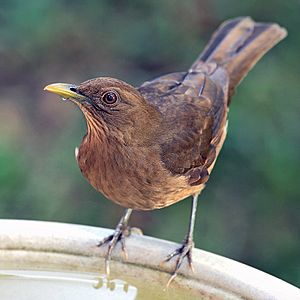
941 bird species have been recorded in Costa Rica (including Cocos Island), which is more than all of the United States and Canada combined! More than 600 of these species live in Costa Rica permanently, and over 200 are migrants, meaning they spend parts of the year outside the country, usually in North America. Seven of Costa Rica's bird species are found only there, and 19 are globally threatened. Costa Rica's birds range in size from the tiny scintillant hummingbird, at 2.2 grams (0.08 oz) and 6 cm (2.4 in), to the huge jabiru, at 6.5 kg (14.3 lb) and 150 cm (60 in).
Scarlet macaws are a common bird species in Costa Rica. Unlike many birds, macaws form a pair for life and stay together to raise their young. Both male and female macaws help care for their chicks for up to two years before they learn to fly. A big threat to macaws is their popularity in the pet trade. One macaw can be sold for up to a thousand dollars.
The resplendent quetzal, a stunning bird with beautiful feathers, can also be found in parts of Costa Rica. The bird's long gray and black tail feathers can be up to a meter (about 3 feet) long and are its most famous feature. Resplendent quetzals live in cloud forests and are most active high up in the trees. You can find them in several of Costa Rica's parks and reserves, including Monteverde Cloud Forest and Braulio Carrillo National Park. Resplendent quetzals eat fruit, insects, small frogs, lizards, and snails, and they have distinctive echoing calls. Sadly, this bird is endangered because its cloud forest home has been largely destroyed across Central America.
Hummingbird species show amazing adaptations with their beak shapes and sizes. Certain species have special beaks that allow them to feed from the flowers of specific plants. The relationship between the hummingbird and the plant is a win-win: the hummingbird transfers pollen between plants in exchange for nectar. Because different hummingbird species are adapted to specific plants, the right plants are pollinated with the right pollen. The mangrove hummingbird is found only in Costa Rica and specializes in feeding from the tea mangrove plant.
Costa Rican officials have thought about closing their national zoos to show an even greater appreciation for the wildlife in their country.
Images for kids
See also
 In Spanish: Biodiversidad de Costa Rica para niños
In Spanish: Biodiversidad de Costa Rica para niños
- Instituto Nacional de Biodiversidad
- Deforestation in Costa Rica


